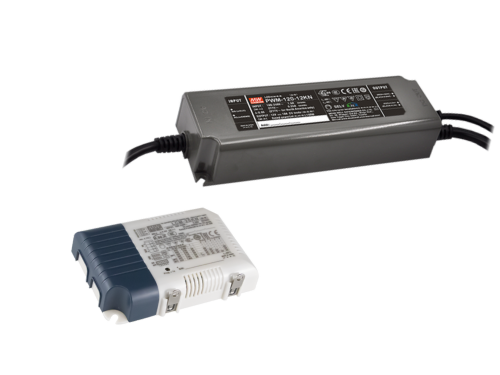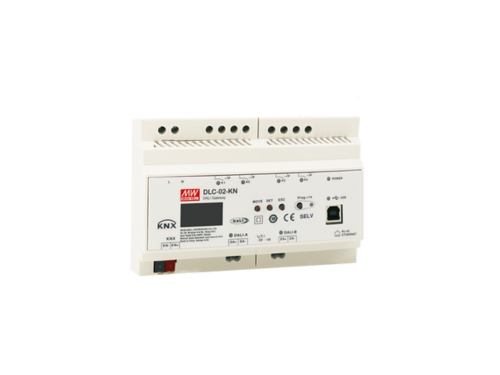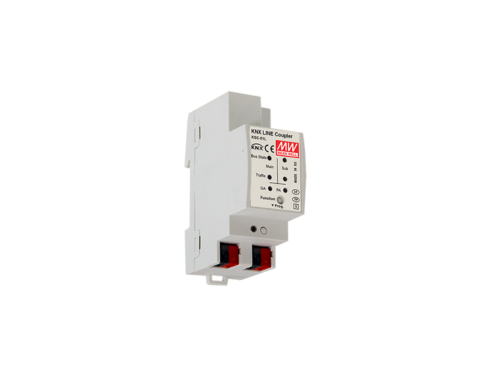Building Automation System
Building Automation System (BAS), also known as Building Management System (BMS), is an intelligent system for modern buildings. These systems offer monitoring functions and enhanced control over electrical and mechanical systems throughout a building. A Building Automation System enables users to control lighting, heating & cooling (HVAC), shutter, security, and many other applications. A well setup BAS will help to run HVAC systems and lighting system more efficiently and reduces energy consumption.
In the current market, several popular control systems exist, such as BACnet, Modbus, DALI and KNX, each with its own benefits and limitations. Depending on the purposes and objectives of the building or smart home, one control system is often customized to meet the specific demands of each situation.
One of the most complete Building automation control systems widely adopted in Europe is KNX. This system offers a uni-communication design between controllers, sensors, and actuators. KNX is specially targeting building, home automation and domotics projects and is one of the few systems which offers solutions to every automation aspect (e.g., HVAC, Acces Control, Sensors, security and lighting) in a Building Automation System.
MEAN WELL KNX PRODUCTS
MEAN WELL is the leading manufacturer of Standard Power Supplies in the market. With over 40 years of experience in the development and production of power supplies, MEAN WELL offers a wide range of high-quality KNX devices in 6 categories as below.
What are benefits of KNX?
KNX is an international recognized standard which covers every automation aspect of home and building control. This standard is adopted by more than 500 members. Some of the key benefits of KNX are:
- Excellent compatibility between KNX devices from different manufacturers
- Endless different automation solutions available in the market (over 10.000 certified KNX products are available)
- Manufacturer independent software (ETS)
- Future proof technology
- Secure system options available
- Easy integration into other BAS (sub)systems, such as Modbus, BACnet & DALI
- Large community and high acceptance rate
- Effortless installation and endless possibilities to expand
With KNX system, users are nowadays able to control all kinds of application devices under the roof of their smart building. KNX IoT (Internet of things) further allows the users to control via KNX app from mobile devices to achieve KNX wireless, which is communicated via KNX IP or KNX RF. Setting up lighting and heating of the building is easier than ever: blinds can now be shut, doors can be locked with one simple touch on the screen. Not only have living and working environments become more convenient and secure, but they are now also more energy-efficient and economical.

What is KNX Secure?
In response to the rising demand of data protection, KNX Secure technology is designed to protect all system data accordingly to the highest encryption standards. KNX Secure signs and encrypts the communication telegrams in the KNX network to avoid the manipulation by unauthorized access or hackers.
The KNX Secure protection is designed in two layers: KNX data secure and IP secure; the former one protects principally the user data against unauthorized access and manipulation, while the latter one aims to ensure that all communication telegrams and data are securely encrypted.
The secured communication data includes the commissioning (configuration) processes with the ETS software, as well as the runtime (daily) communication between KNX devices. The concept ensures that all or selected KNX telegrams are authenticated and encrypted regardless of the medium.
As result, the communication between sender and receiver can be neither interpreted nor manipulated.
KNX Lighting Control
The architecture of the KNX lighting system consists of KNX power supply that supplies the KNX bus and KNX switch actuator which is used to control the LED driver by simply turning on or off. In addition, a KNX presence detector can also be installed to automatically control the light when human or moving objects have been detected.
KNX lighting control systems can be divided into two types: Analog lighting systems and Digital lighting systems. Analog systems tend to be more flexible when it comes to the control over lighting devices, whereas digital lighting systems have as advantage more comprehensive control and the possibility to read out data from the KNX device directly such as power consumption and lamp failure.
Analog lighting systems are in general a combination of KNX actuator, KNX dimming actuator and/or KNX phase cut actuators. These actuators are powered and controlled via the KNX bus and can switch on/off the AC mains by means of a relay. Whereas dimming is achievable by a 0-10V/1-10V signal or by cutting of a phase.
Main advantages of these analog systems are that, in principle, any type of drivers or ballasts can be connected to the KNX actuator, and that a single KNX actuator would allow to switch on all connected fixtures, ballast and or drivers.
Disadvantages of analog systems are that additional wire installation is needed to transfer the 0-10V/1-10V signal, so different wire lengths could result in different light output of the light source, and there could be compatibility issues between KNX Phase cut actuator and phase cut driver.

Currently, there are few options available to make a direct digital lighting control in KNX (or other BAS) systems. The most common solution for a digital lighting system implementation in a BAS is by using a subsystem, and one of the most accepted digital lighting systems is DALI. DALI is an open protocol focusing on lighting control and is accepted by most lighting manufacturers. To create a subsystem in a KNX system, a KNX DALI Gateway is needed to translate KNX commands into DALI commands.
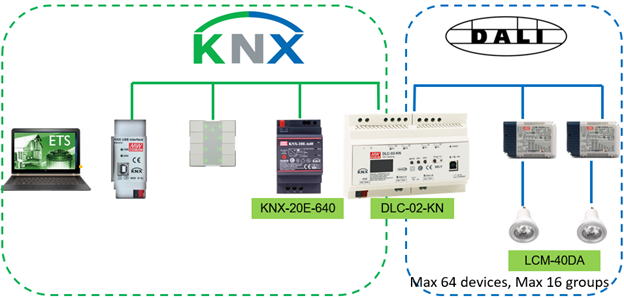
Advantages of Digital Lighting System:
- Easier installation and less wires as it is a bus system with addressable components
- Light levels can be controlled precisely and will be consistent despite the cable lengths
- Read data (Lamp failure, Power consumption)
- Emergency function
- CLO light compensation (LED’s age over the time and CLO will compensate the light output)
- Logarithmic dimmable
- Color control and complex scene setting
Disadvantages of Digital Lighting System:
- Higher cost of the components in the system
- Knowledge is needed for setting up ETS and DALI
- Additional gateway needed
- Gateway is a single point of failure
KNX Direct Digital Lighting Control
One of the drawbacks of using a subsystem for Digital lighting control is the need of gateways which generates additional costs and creates a single point of failure in a digital lighting system. Also, one would need to have the knowledge of 2 different protocols to set up the lighting system.
One should consider why using 2 different protocols when the KNX protocol has all functions to make a direct digital control over a lighting system? MEAN WELL is one of the first manufacturers offering KNX LED drivers which can be controlled directly over the KNX BUS. This is an economical solution as it simplifies the installation by using a single protocol, saving cost of KNX Dali Gateway and removing single point of failures.
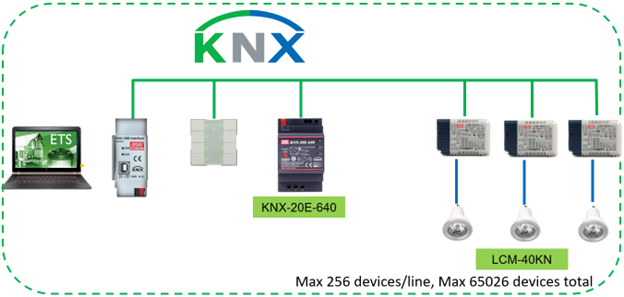
MEAN WELL KNX LED drivers are available as constant current drivers (LCM-25KN, LCM-40KN and LCM-60KN) and constant voltage dimmable LED drivers (PWM-60-KN, PWM-120-KN and PWM-200-KN) with a PWM frequency which can be setup up to 4kHz. The details of these drivers can be found here: KNX Building Automation Solution-MEAN WELL
More information about digital lighting control: Better than DALI: KNX Lighting – All About MEAN WELL Power Supplies
Blind Control with KNX
A KNX blind control or KNX shutter control system is an important element in creating an efficient energy-saving system in modern smart buildings.
Blind and shutter control systems are usually triggered by data provided by KNX Room controllers, KNX Weather stations and/or KNX Light Sensors. Based on the inputs of these devices and the settings made in the ETS software, KNX shutter actuators are triggered to set blinds and shutters in optimal positions to provide energy efficiency, shading and visual comfort.
A simple example of a blind control system is a light sensor installed to measure the sunshine radiation value of a specific indoor space. With collected data, a KNX shutter actuator is programmed via ETS software to control the shading system: when the sunshine is strong, the corresponding blinds or curtain of the wall will be closed to provide shielding, and vice versa.
KNX shutter actuators are the key element in KNX Blind control systems, ensuring the comfort of the indoor environment and promoting the energy efficiency of the smart building. For this, MEAN WELL offers the compact-sized KAA-8R which can control electrical shutter, blinds or curtains systems.
Heating and ventilation System Control with KNX
KNX is the leading system to create an intelligent controlled heating and ventilation and Air-conditioning (HVAC) system. In the market, there are many KNX HVAC solutions available, such as KNX room temperature controllers, Fan Coil controllers and temperature sensors which form the input to manage KNX heating actuators, KNX valve controls, KNX ventilator controller, actuators, and many more to manage climate and environment efficiently and comfortably inside buildings.
Efficient KNX HVAC systems can consist of a KNX temperature sensor to measure the temperature value of the office or a specific indoor space. With these values, a logic controller can control the heating system and adjust the room temperature. To meet this kind application, MEAN WELL has developed the KNX bus power supply KNX-20E and KNX-40E to provide KNX equipment power. The KNX switch actuator, KAA-8R can control the heating circuit and switch on/off the heater on the heat sink or in the underfloor heating system. Depending on the device model and parameter settings, the heating system can be controlled via switching parameters or pulse width adjustment (PWM). It is not only suitable for private residences, but also for commercial building usages, such as office buildings, schools, and hotels.
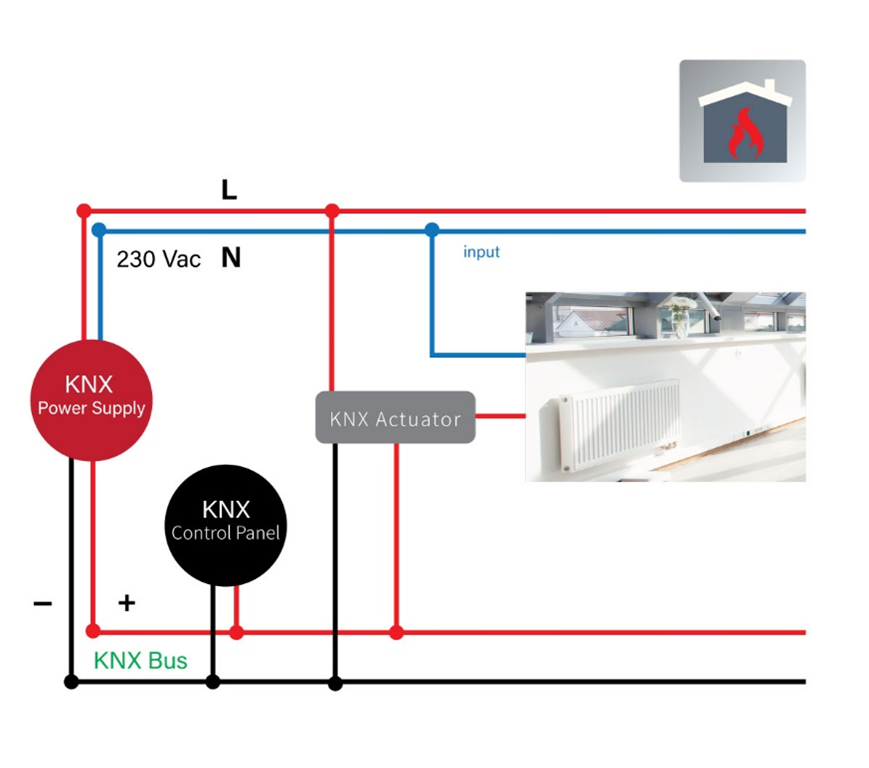
MEAN WELL KNX system product line consists of KNX power supply for KNX bus network, KNX-DALI gateway and KNX-LED drivers. For flexible building management, MEAN WELL KNX actuator can be used to control lighting and HVAC systems. MEAN WELL is the industry leader for industrial power supplies, and offers a complete portfolio of power supply solutions for smart building installations such as the compact and highly efficient HDR series in 15W/30W/60W/100W/150W. To sum up, the portfolio of MEAN WELL KNX system is the intelligent solution for networking, controlling, and powering Smart Buildings.
LEARN MORE ABOUT MEAN WELL KNX SYSYEM
Explore our blog for insightful technical notes about KNX Building Automation Applications.
Got questions?
Look at the section below to find the most frequently asked questions (with answers)
we received in Building Automation Applications.
MEAN WELL’s specification shows the absolute values which were verified during design quality verification tests. Those condition are guaranteed by manufacture from quality and warranty perspectives.
When certifying a power supply according to a certain norm, there is normally a requirement described in this standard a certain tolerance which must be considered. (See also FAQ: Why Is The Input Voltage On The Label Different From The Input Voltage In The Spec? For Example, The Specification Shows Is 88~264 VAC While The Label On The Power Supply Says That It Is 100~240VAC?)
The specification shows what is possible, the report and label of the power supply shows what is approved by the certifying body according to the standards.
Besides the difference due to tolerance there might also be another reason why the specification and label/test report show a different temperature. For example, if the power supply needs to be derated at a low voltage input such as 100VAC, the label and test report might show the max temperature at full load based on this low input.
Different standards might have different tolerance requirements and different ranges this could mean that the most conservative value, or multiple values will show up on the label of the power supply.
In general MEAN WELL’s power supplies with a fan will continue to spin in no load condition. For certain power supplies where the fan will turn off in no load condition this will be marked (1) in the feature section of the specification:

MEAN WELL has incorporated dust proofing and waterproofing into the majority of its LED power supply design. Mainly based on the international standard IEC60529, detailed descriptions can be found in the following table:
(Note: PSUs with IP64 rating or above are suitable for indoor or outdoor applications in sheltered locations)
IP xy protection level
| Degree of protection, foreign bodies (x) | Degree of protection, moisture(y) |
| 0. Not protected 1. Solid foreign object (>50mm) 2. Solid foreign object (>12mm) 3. Solid foreign object (>2.5mm) 4. Solid foreign objects of 1,0mm diameter and greater 5. Amount of dust that would interfere with normal operation Dust tight | 0. Not protected 1. Vertically falling water drop 2. Vertically falling water drop when enclosure is tilted up to 15 degrees 3. Water sprayed at an angle up to 60o on either side of the vertical 4. Water splashed against the component from any direction 5. Water projected in jets from any direction (12.5 liter/minute) 6. Water projected in powerfil jets from any direction (100 liter/minute) 7. Temporary immersion in water ( 1 meeter from the surface of the water for 30 minutes) 8. Continuous immersion in water, or as specified by the user / manufacture |
*IP64-IP66 level products are suitable for damp indoor or sheltered outdoor environment. For actual installation limitations, please refer to the corresponding IP level tests.
*All products cannot be continuously submerged in water.
*The definition of IP68 by MEAN WELL: Immerse a unit under test in 1 meter below the surface of the water, tested with a dynamic condition where 12-hour AC on; 12-hour AC off.
Test duration: 1 month.
Nowadays, customer implement magnetic component in their system to achieve fast installation and maintenance. The magnetic component should keep as far as possible from PSU to avoid interference in the control circuitry of PSU. If limitation of distance is unavoidable, install a well magnetic-conducted metal plate (ex: steel plate, copper plate) between PSU and magnetic component to minimize the interference.
MEAN WELL’s component self-heating can be found on www.meanwell.com
1. Use the search function on the website to find the right product
2. Fill in the series number in the search field (do not include the last extensions such as -12 in XLG-150-12)
3. Click the search button
4. Click on the PDF icon to open the specification

5. Click on report

6. Click on the model and scroll down:

7. The temperature of the critical component can be found in the chapter Reliability Test under item 1 Temperature Rise Test

For more details about the component type for each position, please use the Contact Us function on this website.
MEAN WELL’s DMTBF can be found on www.meanwell.com
Please note that the DMTBF is not for every model available. Mostly this information is available for the LED drivers and our latest product releases.
1. Use the search function on the website to find the right product
2. Fill in the series number in the search field (do not include the last extensions such as -12 in XLG-150-12)
3. Click the search button
4. Click on the PDF icon to open the specification

5. Click on report

6. Click on the model and scroll down:

7. The DMTBF is shown on the last page of the report in the chapter Reliability test

MEAN WELL’s MTBF can be found on www.meanwell.com
1. Use the search function on the website to find the right product
2. Fill in the series number in the search field (do not include the last 3. extensions such as -12 in XLG-150-12)
3. Click the search button
4. Click on the PDF icon to open the specification

Scroll down in the specification to the bottom of the second page

5. Find the MTBF value in under others:

MEAN WELL’s capacitor lifecycle calculation can be found on www.meanwell.com
1. Use the search function on the website to find the right product
2. Fill in the series number in the search field (do not include the last extensions such as -12 in XLG-150-12)
3. Click the search button
4. Click on the PDF icon to open the specification

5. Click on report

6. Click on the model and scroll down:

7. The Capacitor life cycle calculation is shown on the last page of the report in the chapter Reliability test

The Capacitor life cycle calculation is considered as the key indicator for the lifetime of the power supply. Please refer to the test report of the power supply on www.meanwell.com for the capacitor life cycle calculation.
As a rule of thumb, every 10dC increase the lifetime will be cut in half and vice versa for every 10dC decrease in temperature.

In the above example, if the power supply is used at 75dC at Ta 40dC, the estimated lifetime would be 2*104095 Hrs ~200K hrs.
This depends on the condition the power supply is used in. Please contact us for specific situations.
In general, the possibility to use the power supply in a higher temperature than specified is very low and all certifications of the power supply will become invalid.
MEAN WELL offers a selection of Surge Protection Devices to protect the power supply against surges and voltage peaks.
- Select products
- Type in “SPD” in the search field
- You will find several available SPD’s

Most small wattage and fanless power supplies are mainly installed in the horizontal position. If you have to install it vertically because of mechanical limitation, you should consider the output derating due to the heat concern. The temperature derating curve can be found on the spec sheet. Regarding the power supplies with built-in fan or the application has forced cooling system, vertical and horizontal installations have less difference. Ex. In SP-150 derating curve, the ambient temperature difference in application is 5 Celsius from vertical to horizontal. The output wattage in forced cooling can be 20% higher than air cooling convection.

Depending on the cooling mechanism of the power supply there are different considerations and restriction towards the mounting orientation of the power supply and distance towards other components and self-heating components.
In general, please check our power supply user manuals on www.meanwell.com (Installation Manual-MEAN WELL Switching Power Supply Manufacturer). The actual distance and orientation depend normally on system design. Customers must review and test the power supplies in the real application and environment.
General guidelines for power supplies with different cooling mechanisms:
- Power supplies with an internal fan or which are cooled with an external fan have less constraints regarding the orientation in which they are mounted. Nevertheless, the fans and ventilation holes must be kept free from any obstructions. Also, a 10-15 cm clearance must be kept from any adjacent heat source
- A convection cooled power supply with standard a vertical mounting orientation which will be mounted in another orientation have to be derated by 5dC. See FAQ What should be noticed when installing a power supply in vertical and horizontal directions? Additionally ventilation holes must be kept free from any obstructions. Also, a 10-15 cm clearance must be kept from any adjacent heat source
- Din rail power supplies can only be mounted in the specified orientation. This is with the ventilation holes at the bottom and on top of the power supply. No other mounting directions are recommended. Allow good ventilation clearances, 5mm left and right, 40mm above and 20mm below, around the unit in use to prevent it from overheating. Also, a 10-15 cm clearance must be kept when the adjacent device is a heat source.
- For conduction cooling power supplies, the temperature on the Tc point is the key indicator if a mounting position can be allowed. The Tc position (1) and max Tc temperature (2) can be found in the product specification. Conduction cooled power supplies are for example IP65~IP68 LED drivers and base plate cooled power supplies such as UHP)


In MEAN WELL’s specification you can find 2 derating curves, in below example the 300W open frame power supply: EPP-300
- The Derating Curve with the Ambient Temperature vs. Load
- The Derating Curve with the Input Voltage vs. Load

- In this Curve one can find that the maximum load of this power supply is 300W at 50dC when an external air flow of 20.5CFM is applied. For temperatures exceeding 50dC, 60dC for example additional derating need to be applied, in above case at 60dC the maximum load would be 225W. (50dC 300W, 70dC 150W => from 50dC to 60dC: 75W derating)
- In case this power supply would be used at 90VAC input, a derating of 80% must be applied. So, in previous example with the 20.5CFM forced air the max load would be 240W. In case of an ambient temperature of 60dC and a 90VAC input the maximum rated power would be 225W * 0.8 = 180W with 20.5CFM forced air.

- If the power supply is used in an application without additional forced Air, the power supply will be derated to 200W till a maximum temperature of 50dC
- In case it will be powered by a 90VAC input the power supply has to be additionally derated to 80% of the 200W = 160W max
LED Drivers are recommended operate at full load as long as it observes the working temperature specified in the datasheet, which means Tc measurement results should be equal to or less than the stated Tc in the datasheet. 5 years warranty complies as long as drivers operate within working Temperature and Tc. Limit as well.
MTBF (Mean Time Between Failure) and Life Cycle are both indicators of reliability. MTBF can be calculated by two different methodologies, which are “part count” and “stress analysis”. The regulations, MIL-HDBK-217F Notice 2 and TELCORDIA SR/TR-332(Bellcore) are commonly used to calculate MTBF. MIL-HDBK-217F is a United States military standard, and TELCORDIA SR/TR-332(Bellcore) is a commercial regulation. MEAN WELL utilize MIL-HDBK-217F(Stress Analysis) as the core of MTBF. The exact meaning of MTBF is, after continuously using the power supply for a certain amount of time, the average time that the probability of proper operation is down to 36.8%(e-1=0.368). Currently MEAN WELL is adopting MIL-HDBK-217F, to predict the expected reliability through Stress Analysis (excluding fans); this MTBF means the probability of the product can continue the normal work after working continuously up to the calculated MTBF time is 36.8% (e-1=0.368). If the power supply is continuously used at double the MTBF time, the probability of proper operation becomes 13.5%(e-2=0.135.
DMTBF (Demonstrated Mean Time Between Failures) is a way of evaluating MTBF in a relatively short period of time based on accelerated deterioration (high stress, high temperature) tests under specific parameters and conditions. Please refer to the following equation for MTBF calculation.
This method compares to the previous methods, this calculation uses real test data to demonstrate the reliability of the power supply.

Where
MTBF: Mean Time Between Failure
- X2:Can be found in chi-square distribution
- N:Number of sampling
- AF:Acceleration factor, which can be derived from acceleration factor equation.
- Ae=0.6
- K(Boltzmann Constant)=(eV/k)
- T1:Rated temperature of specification. Note: Kelvin will be the unit use for calculation
- T2:The temperature that is used in the meaning of acceleration, and the chosen temperature could not result in physical change in materials.
Note: Kelvin will be the unit use for calculation.
Life Cycle (Capacitor Life Cycle) is found by using the temperature rise of electrolytic capacitors under maximum operating temperature to estimate the approximate life of the power supply. For example, RSP-750-12 MTBF=109.1K hours(25°C); electrolytic capacitor C110 Life Cycle=213K hours (Ta=50℃).
MEAN WELL considers the capacitor lifecycle calculation as the most important indicator for the estimated lifetime. The (D)MTBF is the main indicator for the reliability of the power supply. For more information please see: Investigation of The Lifetime & Reliability of Power Supply -MEAN WELL EUROPE Switching Power Supply


